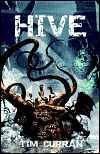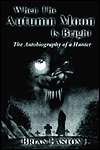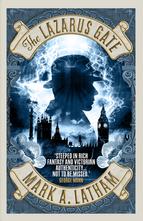
Hive, by Tim Curran
Book Review by Jeff Edwards
Have you read this book?
Despite the prospect of another long, dark winter, excitement is running high at Kharkhov Station
in Antarctica. Scientists have discovered the ruins of an ancient city beneath the ice, and are
bringing some prehistoric mummies back to the station for further study. But anticipation turns to
terror as the creatures begin to thaw, and history is doomed to repeat itself in Hive, Tim
Curran's sequel to H.P. Lovecraft's "At the Mountains of Madness."
Writing a sequel to an icon of speculative fiction is a daunting task, but Curran proves that he's up to the challenge. From page one, his words demand to be savored for their mesmerizing power and strong imagery: Antarctica as cemetery; winter as hungry beast. Lovecraft fans will feel the thrill of recognition at Curran's first description of an Old One: a seven-foot, barrel-shaped creature with wings, tentacles, triangular spade-like feet and a head shaped "like a great five-pointed starfish."
Using Lovecraft's novella as a foundation, Curran updates and expands the tale: Hive is set in modern times with a working-class main character, and further explores the dynamics between the Old Ones and humans. According to Lovecraft, the Old Ones regarded man as a "shambling, primitive mammal, used sometimes for food and sometimes as an amusing buffoon." But Curran reveals a far more predatory relationship: a mental battle pitting humanity against an ancient, overpowering intellect.
Curran's story fares well when compared to Lovecraft's: Contemporary audiences might even prefer the sequel over the original, given Lovecraft's often tedious prose. Ultimately, however, Hive's potency is diluted by the numerous writers and filmmakers who have already followed Lovecraft's lead. When Curran says that "myths and legends concerning winged demons...might be race memories," it sounds like the explanation for "all the myths and legends" of the Devil in Arthur C. Clarke's novel "Childhood's End": "Could it be that...there was such a thing as racial memory?" And fans of Ridley Scott's "Alien" or John Carpenter's "The Thing" may feel like they've already watched scenes from Hive up on the silver screen decades ago. Curran tries to address the issue by making references to both versions of "The Thing" within his story. But the damage is already done, and so the climax in Hive seems, well, anticlimactic (Curran even writes "That's all there was to it") and the final confrontation is just a variation of the mano a mano showdown that we've seen in countless movies over the years.
Perhaps Curran predicted such criticism: In his novel, he writes, "Everything was passed around, re-told, re-invented." This is, after all, "a sequel over seventy years in the making," and genre fiction fans should rejoice now that a gripping, bona fide continuation of Lovecraft's influential novella has finally been unleashed.
Writing a sequel to an icon of speculative fiction is a daunting task, but Curran proves that he's up to the challenge. From page one, his words demand to be savored for their mesmerizing power and strong imagery: Antarctica as cemetery; winter as hungry beast. Lovecraft fans will feel the thrill of recognition at Curran's first description of an Old One: a seven-foot, barrel-shaped creature with wings, tentacles, triangular spade-like feet and a head shaped "like a great five-pointed starfish."
Using Lovecraft's novella as a foundation, Curran updates and expands the tale: Hive is set in modern times with a working-class main character, and further explores the dynamics between the Old Ones and humans. According to Lovecraft, the Old Ones regarded man as a "shambling, primitive mammal, used sometimes for food and sometimes as an amusing buffoon." But Curran reveals a far more predatory relationship: a mental battle pitting humanity against an ancient, overpowering intellect.
Curran's story fares well when compared to Lovecraft's: Contemporary audiences might even prefer the sequel over the original, given Lovecraft's often tedious prose. Ultimately, however, Hive's potency is diluted by the numerous writers and filmmakers who have already followed Lovecraft's lead. When Curran says that "myths and legends concerning winged demons...might be race memories," it sounds like the explanation for "all the myths and legends" of the Devil in Arthur C. Clarke's novel "Childhood's End": "Could it be that...there was such a thing as racial memory?" And fans of Ridley Scott's "Alien" or John Carpenter's "The Thing" may feel like they've already watched scenes from Hive up on the silver screen decades ago. Curran tries to address the issue by making references to both versions of "The Thing" within his story. But the damage is already done, and so the climax in Hive seems, well, anticlimactic (Curran even writes "That's all there was to it") and the final confrontation is just a variation of the mano a mano showdown that we've seen in countless movies over the years.
Perhaps Curran predicted such criticism: In his novel, he writes, "Everything was passed around, re-told, re-invented." This is, after all, "a sequel over seventy years in the making," and genre fiction fans should rejoice now that a gripping, bona fide continuation of Lovecraft's influential novella has finally been unleashed.
|
Click here to buy Hive, by Tim Curran on Amazon
|
Hive, by Tim Curran on Amazon

| More Books You Might Like |
Comment on Hive, by Tim Curran
| Comments on Hive, by Tim Curran |
| There are no comments on this book. |




